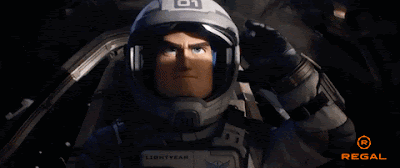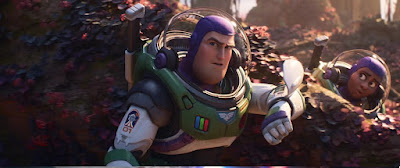To Xfinity and Beyond
or
Just Goes to Show a Movie Can Have Too Much "Buzz"
Buzz Lightyear (Chris Evans), Space Ranger, is on a mission for Star Command, when he's awakened by a signal telling him that they're nearing a planet with life on it. He goes out to explore the planet alone, leaving a team of scientists in hyper-sleep aboard his ship. Alone is what Lightyear does—he's a lone wolf and it's easier to do things himself. The thing is he's not alone: his commander on the mission, Alisha Hawthorne (Uzo Aduba) has tagged along, surprising the bejeezus out of him and noting the fact that he's "narrating again," which Buzz confesses is him doing his Mission Log (which no ever listens to). It helps him focus. What doesn't help him focus is the other member of "The Away Team," a rookie—with a not-very-reassuring reddish color on his uniform (for those of us who know "sci-fi tropes")—named Featheringhamstan (Bill Hader), whose defense stance seems to be "approaching panic." That would be the way to go, actually, as the planet has a slightly spongey surface, all the better for the tentacled underground dwellers to travel through and for the above-ground spider-crabs to scramble over.
But, it doesn't bode too well for any sort of colonization, so after tussling with those species (that's it?), Buzz and Alisha and Feathinghair...Farthinghamster..."the rookie" get back to the ship to try and lift off the thing—noting that their ship (let's call it "The Turnip" because they do) is sinking into the ground. Buzz mans the controls, while Alisha primes the hyper-space crystal for launch. Buzz is determined to get them off the ground, but the ship crashes, leaving them stranded on the planet...and worse for Buzz, leaving the mission uncompleted.Okay, a diversion. But not as big as the one this crew takes to become deserted, so no big deal. Let us explain (as the movie does) that what we are watching is the movie that inspired the "Buzz Lightyear" toy from the always reliable "Toy Story" series that launched Pixar Studios into feature films in 1995 (Andy, the real-live boy from the series, loved the movie and his mom bought him one). So, this is not the toy we're watching, with it's round googly-eyes and the Tim Allen voice and the purpose of comic relief, this is a science fiction adventure film (with humor), rather than a comic film about toys having existential crises. It's a different animal, only tangentially related to the Toy Story franchise.
Affirmative?
Let's move on.
The marooned colonists call the planet T'Kani Prime and their goal is to survive, use the planet's resources and build a launch platform to get them back to Star Command, and within a year, they have built an impressive "Gerry Anderson" inspired complex, complete with a bug-zapping fence and a launch vehicle to get them into space. But, first, they must test the newly-developed hyperspace fuel that could get them home. And that's tricky. They rig up a test-vehicle and select Lightyear—the fellow who crashed the original craft stranding them in the first place—to pilot the ship.The test flight goes well...until it doesn't. That hyperspace fuel becomes unstable and Lightyear is unable to achieve the speed necessary to go full-hyperspace (it's amazing how similar the sequence looks to the early test flight in Top Gun: Maverick), but, he's able to get the ship back to planet, even though the mission is, technically, a failure.
But, he's greeted with surprise, even shock. "Buzz! It's good to see you!" For Buzz, the trip took hours. For the colonists it took "4 years, 2 months, and 3 days." The speed that Buzz achieved on-board his ship created "time dilation" so that a moment for him, would be days or weeks for everybody else—please see Interstellar for reference. Relatively speaking, Buzz has missed the 4 years plus, the colonists have experienced and there have been changes—in technology and people. To deal with the psychological consequences, Buzz is given a robotic therapy cat, Sox (Peter Sohn), but what he's itching to do is test the new hyperfuel again to see if it has made enough improvement to get everybody home.So, he goes up again, with the same results. The hyper-fuel becomes unstable, and when he lands another 4 years have gone by: Alisha is in a relationship, his friends are older, the colonists have made more improvements and they have a new fuel prototype.
So...it's time to test again. Buzz goes up, the hyper-fuel becomes unstable, he lands, and another 4 years have gone by. Alisha is married, pregnant, and there's a new hyper-fuel. You get the pattern.
So...it's time to test again. Buzz goes up, the hyper-fuel becomes unstable, he lands, and another 4 years have gone by. Alisha is married, pregnant, and there's a new hyper-fuel. You get the pattern.
Buzz goes up again and again, each trip adding another 4 years to everybody else's life while Buzz stays in place in a sci-fi metaphor for life passing him by. Until the day that he goes up and the hyper-fuel—now designed by Sox the robo-cat in a long gestating project—is able to maintain integrity to make the jump to hyper-space. He's done it. The mission is achievable. He's able to get everybody home.
But, no one wants to leave. The jump to hyper-space has increased the time dilation so that 22 years (14 weeks, 3 days) has elapsed. Alisha is dead, her children grown, with grandchildren and the colony has made a stable life for everyone concerned. Buzz's mission is no longer relevant. But, a new threat has emerged: Zyclops robots, led by the evil overlord Zurg (James Brolin), have occupied the planet, the colony protected by a laser shield that is constantly under attack. And, there's a "rag-tag" group of defense forces—Darby Steel (Dale Soules), Mo Morrison (the ubiquitous Taika Waititi), and Izzy Hawthorne (Keke Palmer), Alisha's granddaughter, who join up with Buzz to try and defeat the Zyclops army.Lightyear is absolutely gorgeous, as the Pixar team of artists have (again) pushed the limits of detail and design to bring the world—and new worlds—to life. But, the film disappoints. It's not because of Evans as the voice of Lightyear (he's great, paying homage to Tim Allen's legendary work as toy-Buzz, while giving this Buzz his own tamped-down personality), and it's certainly not due to any issues having to due with a same-sex relationship which flits by in the background while Buzz Lightyear obsesses over his one true purpose. These are prickly little "dog-whistle" issues that don't even deserve an internet comment (although there are many, all deserving to be dismissed).
No. The problem is the character of Buzz Lightyear, who is—necessarily—not the same goofy, though good-hearted, character of the "Toy Story" films, but is—in all senses of the term—his own man. Almost buffoonishly so. While the rest of the world changes, he stands, alone in his own stubbornness. He's a misanthrope, a Rip Van Winkle, out of time and space. In a way he's a bit like Ethan Edwards in The Searchers (but without the virulent racism) or The Outlaw Josey Wales (without the tragedy)—he even inherits an ersatz family which he initially scorns, ala Josey. But, unlike those he doesn't have a distinctive emotional epiphany—oh, he has one when he's confronting himself (and to explain that, you'd have to see the film), but it's so weighted down with an action sequence that one might be forgiven if it escapes one's notice.
And it takes so long for him to come to his conclusions that he seems a little dense to what is going on all around him. Maybe it's all that narrating....spending too much time in his own bubble helmet.
Maybe I'll revisit Lightyear in 4 years, 2 months and 3 days, and perhaps find some aspect that might make him a hero...or even someone you'd want an action hero figure of.
Because for someone whose catch-phrase is "To Infinity...and Beyond(!)" he should perhaps choose "Affinity," instead. Until then, Lightyear will just be another lackluster choice in endless rotation on Xfinity.
Maybe I'll revisit Lightyear in 4 years, 2 months and 3 days, and perhaps find some aspect that might make him a hero...or even someone you'd want an action hero figure of.
Because for someone whose catch-phrase is "To Infinity...and Beyond(!)" he should perhaps choose "Affinity," instead. Until then, Lightyear will just be another lackluster choice in endless rotation on Xfinity.














No comments:
Post a Comment